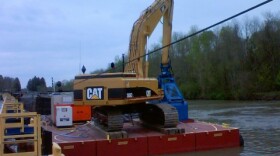With the deadline for public comment Friday, the New York state Department of Environmental Conservation has sent a letter to the U.S. Environmental Protection Agency asking it to remain on the Hudson River for further removal of toxic PCBs.
For the past several months, the EPA has been taking comments on its second five-year review report on General Electric’s cleanup of a 40-mile stretch of the Hudson River from Fort Edward to Troy.
Under consent order, GE removed 2.75 million cubic yards of contaminated sediment and remains on the river for monitoring and habitat restoration work.
In its report released June 1st, EPA wrote, “The remedy is functioning as intended, although human health and ecological remedial goals have not yet been achieved,” consistent with the agency’s predictions.
On Wednesday, New York State Department of Environmental Conservation Commissioner Basil Seggos said the work done so far is not protective of public health.
“We are confident based on the data that we already have on hand from EPA and the conclusion that EPA has already sent out there in draft form, that this remedy cannot be protective,” said Seggos.
Seggos said any remedy “that fails to meet its goals for 55 years is not protective.”
Following the release of the report in June, DEC began its own sampling effort after it asked the federal agency to conduct additional sampling.
This week, DEC was set to finish collecting 1,600 sediment samples. The samples will be analyzed and evaluated to determine recovery rates and pinpoint areas where high pollution levels remain.
EPA collected 375 samples to inform its five-year review report.
“I know it’s a full-court press on all sides here. We’ll make our case. We have made our case in writing. We’re going to continue doing testing and sampling and supplying that information to the EPA in an effort to get them to change their posturing. If they don’t, obviously we’re going to have to review our options,” said Seggos.
State and local officials, as well as environmental organizations, up and down the river have been calling for additional cleanup since the release of the five-year review. Democratic Assemblywoman Carrie Woerner, represents portions of Saratoga and Washington Counties, where much of the dredging work occurred.
“To their credit, they’ve held three public hearings. Hundreds of people have participated. And universally we are calling for EPA to require further cleanup of the river,” said Woerner.
Woerner echoed Seggos in saying that a sound cleanup is necessary for the environment and also for local economies.
Officials have called for additional PCB removal and navigational dredging in the Champlain Canal, an item not included in the original consent order between EPA and GE. The New York State Canal Corporation has submitted an application to the Army Corps of Engineers for the work.
EPA will continue accepting comments through September 1st.
General Electric stands its work dredging the Hudson, as spokesman Mark Behan previously told WAMC.
“Since dredging was completed PCB levels in upper Hudson have already shown significant declines, EPA has declared the project a success, and said no additional dredging was necessary,” said Behan.
Behan has said that GE will “continue to support the ongoing assessment of environmental conditions in the river and work closely with EPA, New York State, local communities and others committed to the goal of a cleaner Hudson.”








